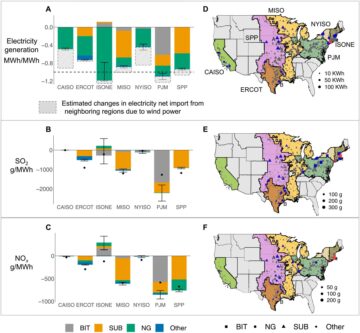The climate crisis is the most complex issue facing us today — it is experienced on a global scale and will be for decades and centuries to come. Scientific evidence, economics, social life, justice, and politics are constantly weighed and assessed as solutions are planned. Yet innovation in cleantech from sectors like sustainable transportation, energy transitions, building efficiency, agricultural analysis, and so much more has become ubiquitous in the 2020s. Hope now prevails that the climate crisis can be mitigated through innovation.
Innovation has spurred what two International Monetary Fund (IMF) authors, Kelly Levin and Andrew Steer, are calling an “inflection point.” They argue that hope is now edging out despair around the climate crisis as innovation has driven down costs and introduced new technologies.
- In 2021, more than 60 countries — representing over half of global emissions — have committed to net zero emissions by mid-century.
- 4,500 companies, cities, regions, and other institutions have embraced a net zero target.
- Divestment is in the news almost daily now, with fund managers and investors triggering $40 trillion of assets committed to net zero portfolios by 2050.
Innovation has occurred in likely and unlikely places: institutions, understanding, technology, and leadership. Systemic change can occur, as history has demonstrated, when the right combinations of drivers come together.
- The Paris Agreement, with a voluntary nature and non-binding targets, was grounded in an inauspicious start of commitments. Yet growing scientific evidence supported by falling technology costs due to cleantech innovation led to rising citizen demands for action. Targets increased as a result, with the need for more robust commitments in the years ahead.
- Economic understanding of climate change started with a perspective that it was prudent to weigh the benefits of avoided costs in the distant future with a kind of discount rate. Now more economists recognize that smart action against climate change in the here-and-now leads leads to increased efficiency, drives new technology, and lowers risk. These benefits, in turn, stimulate investment, generate jobs, create healthier economies, and boost the livelihoods and well-being of citizens.
- Leadership, driven by the Intergovernmental Panel on Climate Change (IPCC) with their conclusion that the risks of 2°C average warming were simply too great, has made the magnitude of the the crisis apparent and part of contemporary discourse. Investors, staff, and customers rose up, saying they wanted visionary leaders on the right side of history. Enlightened figures of authority recognized that they had to fully commit to manage risks and seize opportunities.
Levin and Steer remind us that we must act in ways that may be unsettling to achieve ambitious but imperative climate goals.
“Even if pledges are fully implemented, there remains a wide gulf between our current emissions path and one that achieves the Paris Agreement’s goals. Communities around the world are seeing the impact of just 1°C of warming, from extreme heat to uncontrollable fires to withering food crops to disappearing ice. The future world will be increasingly unrecognizable unless we transform our actions.”
The IEA estimates that $90 billion in public financing is needed to support demonstration projects for the energy transition before 2030. Yet only $25 billion is budgeted over the next decade. New ways to leverage private investment, boost and better align government spending, tailor policy and regulatory frameworks to an innovation agenda, and insulate for additional reductions of risk are needed to attract more private investment. Developing economies, in particular, need significant support, say Levin and Steer, in the form of financing, technology transfer, and capacity building in order to reap the benefits of innovation and move to a low-carbon future.
The Scope of Innovation Ahead is Daunting, But Possible
Innovation in finance, institutional design, novel partnerships, philanthropy, and international cooperation can assist with climate mitigation and adaptation strategies. Some trends already show incredible promise. Battery pack prices have fallen almost 90% over the past decade. The exponential growth in renewables makes them the technologies of choice in many places. Adoption of electric vehicles (EVs) has accelerated, with a growing number of governmental phaseouts of internal combustion engines, subsidies to increase EV demand, and car companies’ embrace of EV fleet targets.
What needs to be done to continue to scale the transformation to a zero emissions global society and limit global warming? Levin and Steer offer a series of necessary innovations.
- The share of renewables in power generation must move from about 25% today to almost 100% by 2050.
- Unabated coal will need to be phased out 6x faster than it is today.
- Our buildings must be renovated so zero-carbon heating and cooling and improved energy efficiency build to at a rate of 2.5–3.5% by 2030.
- Crop yields must double over recent rates in the coming decades in order to meet a growing population’s food needs — and it must be done without encroaching upon forests, avoiding agricultural expansion, and maintaining soil health as well as water quantity and quality.
Innovation will be critical to achieving these goals by 2030 and is largely achievable with readily available technologies. Efforts to spur innovation must focus on research and development of these technologies and the technologies and infrastructure these solutions depend on.
RMI (formerly the Rocky Mountain Institute) adds that we must also quickly retire carbon intensive assets, well ahead of the end of their economic and technical lives. They outline that coal plants must be closed, fossil fuel subsidies must end, and no new fossil fuel infrastructure can be built — including demand-side infrastructure such as highway expansions and gas distribution systems.
Reliance on technologies still under development is even higher for harder-to-abate sectors, such as long-distance transportation and heavy industry. Researchers from the National Renewable Energy Laboratory (NREL), in collaboration with two electric utilities, recently studied a promising opportunity for near-term electrification within this segment through depot charging. NREL researchers simulated multiple charging strategies, including “smart” charging, where BEVs take full advantage of the time spent parked at the depot to charge at slower rates and reduce peak energy demand. This study shows that charging requirements could be met at power levels in line with current light-duty charging technology (≤100 kW/vehicle) for the fleets studied.
Levin and Steer use the example of direct air capture and storage as an innovation opportunity. The IPCC and National Academies of Sciences suggest that, by mid-century, 8–10 gigatons of carbon dioxide (GtCO2) may need to be removed annually. Natural approaches, such as landscape restoration, may remove 5–6 GtCO2, with significantly renewed efforts, but engineered approaches could remove and store carbon as much as the latest science suggests is necessary. Scaling capture and storage will not only rely upon technological innovation to reduce energy inputs and costs — it will also depend on policy support such as tax credits, greater market demand, and public and private investment.
Final Thoughts About The Power Of Hope
Of course, entrenched and insistent business and political leaders, as well as critical segments of the population, have vested interests in maintaining the status quo and are resisting change away from a fossil fuel-driven world. The discourse around the climate crisis is messy. Levin and Steer insist that government measures must ensure that transitions are just and equitable, especially for workers and industries currently tied to a carbon-intensive future. Just this week, Energy Secretary Jennifer Granholm on defended the Biden administration’s proposal to give tax credits for electric vehicles made by unionized automakers. The Build Back Better bill hangs in a precarious limbo at this writing.
Yes, we are far from an emissions trajectory that avoids even worse effects of climate change, so innovation must accelerate throughout the current decade. By mid-century, almost half of required emissions reductions will call for technologies that are not yet on the market. As the Union of Concerned Scientists makes abundantly clear, “Wish as we might, we will not whoopsie-pie our way into the Great Decarbonized Place. We need actual action. We need actual policy, actual progress, actual change commensurate with the level of action these climate targets require.”
Appreciate CleanTechnica’s originality? Consider becoming a CleanTechnica Member, Supporter, Technician, or Ambassador — or a patron on Patreon.


Source: https://cleantechnica.com/2021/11/01/innovation-leads-to-hope-amidst-climate-crisis/
- 2021
- Action
- Additional
- Adoption
- ADvantage
- Advertise
- analysis
- Annually
- around
- Assets
- authority
- authors
- automakers
- battery
- biden
- Bill
- Billion
- build
- Building
- business
- call
- Capacity
- car
- carbon
- carbon dioxide
- change
- charge
- charging
- Cities
- cleantech
- Cleantech Talk
- Climate change
- climate crisis
- closed
- CNBC
- Coal
- collaboration
- coming
- Communities
- Companies
- continue
- Costs
- countries
- Credits
- crisis
- crops
- Current
- Customers
- Demand
- Design
- Development
- Discount
- driven
- Economic
- efficiency
- Electric
- electric vehicles
- Emissions
- energy
- energy efficiency
- estimates
- EV
- expansion
- facing
- finance
- FLEET
- Focus
- food
- form
- Fuel
- full
- fund
- future
- GAS
- Global
- global warming
- Goals
- Government
- governmental
- great
- Growing
- Growth
- Guest
- Health
- history
- HTTPS
- ICE
- IEA
- Impact
- Including
- Increase
- industries
- industry
- Infrastructure
- Innovation
- Institutional
- institutions
- International
- investment
- Investors
- IT
- Jobs
- latest
- Leadership
- Led
- Level
- Leverage
- Line
- low-carbon
- Market
- move
- net
- news
- offer
- opportunities
- Opportunity
- order
- Other
- paris
- partnerships
- Patreon
- perspective
- plants
- podcast
- policy
- population
- power
- private
- projects
- proposal
- public
- quality
- Rates
- reduce
- regulatory
- renewable energy
- Renewables
- Requirements
- research
- research and development
- Risk
- Scale
- scaling
- Science
- SCIENCES
- Sectors
- Seize
- Series
- Share
- smart
- So
- Society
- Solutions
- Spending
- start
- started
- Status
- storage
- store
- Study
- support
- Supported
- sustainable
- Systems
- tax
- Technical
- Technologies
- Technology
- The Future
- the world
- time
- Transformation
- transportation
- Trends
- us
- utilities
- Vehicles
- Water
- week
- weigh
- within
- workers
- world
- writing
- years
- zero





